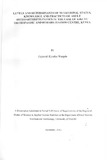| dc.description.abstract | Osteoarthritis (OA) is the commonest condition that affects human beings; however, there is paucity of information in its management in Kenya and Africa at large. According to the Association of Arthritis and Rheumaac Disease of Kenya (AARD) there is sufficient evidence that arthritis is a growing burden in this country hence the need to improve quality of life of arthritis sufferers by empowering them to participate in their own care by being part of the treatment plan which involves medication, diet, weight management and physical activity. The objective of this study was to determine the nutritional status, knowledge and practices of adult OA patients. The study took place at Kikuyu Orthopedic and Rehabilitation Centre (KORC) in Kikuyu County from November 2011 to January 2012. A structured questionnaire was pretested and used to collect information on socio-economic demographics, nutritional knowledge, dietary diversity and level of physical activity. Anthropometric measurements of height and weight were used to calculate BMI and determine nutritional status of the patients. Focus Group Discussion guide and Key Informant interview guide were used to collect qualitative data. SPSS 16.0 and Ms-Excel 2007 software was used for statistical data analysis.
A sample size of 205 OA patients was determined using the Fischer's formula. The study design was cross-sectional, descriptive and analytical in nature. Sampling procedure involved purposive sampling of KORC and exhaustive sampling method was used to select respondents. The respondents were aged between 18-74 years and 26.8 % were male while 73.2 % were female, 31.2 % of the respondents originated from Nairobi County and 30.7 % from Kiambu County. The study showed that more than two thirds (80.2 %) of the respondents hal low level of knowledge (scored 0 % to 40 %), 8.7 % correctly described a balance diet as die containing carbohydrates, proteins, fats, vitamins and minerals and 67 % described it a: adequate amount offood. Eighty six (86 %) of the respondents bad moderate dietary diversity score consuming between 4-8 food groups in a day. Fifty percent (50 %) of the respondents reported that they suffered from other diseases with 45 % suffering from hypertension and 25 % from diabetes mellitus.
In conclusion, OA patients have low nutritional knowledge. Their daily dietary intake of fruits (30.7 %), eggs (7.3 %), milk and milk products (15.6 %) is low while that offish and sea foods (3.4 %) which are known to be rich in omega 3 and Vitamin D is extremely low. Majority of the patients are overweight or obese (71 %). Physical activity level is moderate while sedentary behavior mean time is 4.8 (ᄆ2.2) hours. Education level is related to nutritional status (r=O.360, p=O.014), knowledge (r=O.419, p=O.024) and dietary practices (r=O.539, p=O.002). There is a positive association between nutrition knowledge and dietary diversity (r=O.127) (p=O.04). Physical activity is related to nutritional status (X2=10.129, P=O.03). Approximately 42.9 % of the variance of nutritional status is accounted for by age, monthly income and education level. To improve patient's nutritional status and knowledge therefore there is need to educate the public on healthy habits such having a balanced diet and exercising. Nutritionists should work closely with OA patients in order guide then on appropriate diet, weight management and physical activity. | en_US |

